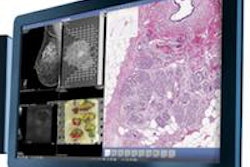
A commonly used method for evaluating the display performance of monitors used for viewing medical images can have some important limitations to be aware of, especially if testers aren't experienced with scoring the qualitative test patterns, researchers from the University of Algarve in Portugal recently reported.
The research team used the TG-18 imaging display test patterns from the American Association of Physicists in Medicine (AAPM) on more than 40 diagnostic monitors. They experienced a number of issues with the popular quality assurance (QA) method, including its reliance on many qualitative tests that can be challenging to perform in hospitals without medical physicists.
In addition, monitors that are near the limits for conformance are considered just as equivalent as monitors that are far from the limits, according to co-author Kevin Barros Azevedo. He shared the research during a presentation at the recent ECR 2016.
Ensuring display quality
Medical images are evaluated on diagnostic displays in radiology departments, as well as on secondary displays in emergency departments or other areas of the hospital. As a result, the researchers sought to determine if the TG-18 display evaluation criteria developed by the AAPM are effective for evaluating the quality parameters of diagnostic monitors, Azevedo said.
In particular, they wanted to check to see if primary diagnostic monitors and secondary displays meet minimum quality parameters. They also wanted to compare the results from primary monitors with the results for secondary diagnostic monitors, and to identify the quality control that most affected the parameters, Azevedo said.
Utilizing the TG-18 test patterns and a RaySafe Xi Light detector (Unfors RaySafe), the researchers studied 42 diagnostic monitors from several hospitals, including 31 monitors used for primary diagnostic interpretation and 11 secondary monitors normally utilized for image postprocessing. Azevedo noted his facility does not have any medical physicists at their hospitals so radiographers performed the tests.
| Conformity with AAPM TG-18 requirements for display parameters | ||
| Conformity of primary diagnostic monitors | Conformity of secondary monitors | |
| Geometric distortion | 58.1% | 90.9% |
| Luminance response | 100% | 100% |
| Maximum luminance | 74.2% | 54.6% |
| Diffuse reflection | 100% | 72.7% |
| Resolution | 100% | 100% |
| Environmental luminance | 100% | 100% |
| Noise | 22.6% | 90.9% |
| Internal reflection (qualitative assessment) | 90.3% | 36.4% |
| Internal reflection (quantitative assessment) | 9.7% | 27.3% |
| Illuminance | 41.9% | 9.1% |
The researchers noted the rates of conformity for all display types were highest for luminance and contrast uniformity (90.5%) and diffuse reflection (92.9%). The two lowest overall levels of conformity were quantitative assessment of internal reflection (14.3%) and illuminance (33.3%).
"Also, the percentage of conformity was higher in the primary monitors, despite that, there were no significant differences between primary and secondary diagnostic monitors," he said.
Some limitations
The results highlight some limitations in the AAPM monitor testing standard, he said. For example, conformity is considered equivalent in monitors that are near the limit, as well as in others that are far from the limit.
"[Also], many evaluations are qualitative instead of quantitative, and we had some difficulty [in scoring the qualitative tests], probably because we are not experienced enough with monitor scoring," he said.
As a result, the anatomical patterns checklist should be more precise, according to Azevedo.



















